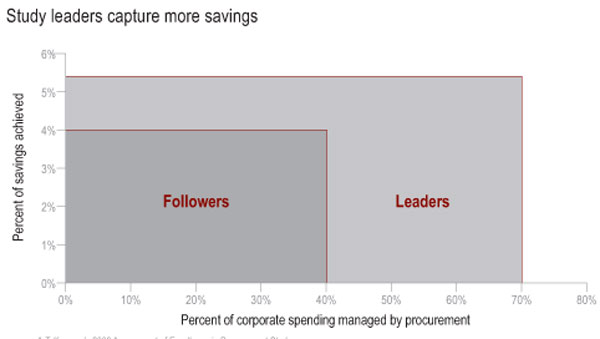SCDigest
Editorial Staff
| SCDigest Says: |
 The companies Kearney classifies as procurement leaders manage about 70% of the enterprise's total spend through the formal procurement organization, versus just 40% for the followers. The companies Kearney classifies as procurement leaders manage about 70% of the enterprise's total spend through the formal procurement organization, versus just 40% for the followers. 
|
In all sectors and functions, there are leaders, followers, and laggards. What’s often difficult, however, is really identifying what makes those leaders different from the rest.
Every few years, the consultants at ATKearney take a look at this question in the area of procurement.
One finding that is perhaps obvious at one level, but a bit non-intuitive at the same time, is that the top procurement organizations simply manage more of a company’s total spend – and generate more total savings as a result.
As shown in the graphic below, the companies Kearney classifies as procurement leaders manage about 70% of the enterprise's total spend through the formal procurement organization, versus just 40% for the followers. Kearney also finds the leaders deliver almost 5.5% spend savings, versus just 4% for the follower group.

Of course, there are questions about cause and effect. What is it about managing more of corporate spend that causes a greater total cost reduction percentage? Or is it that the more capable procurement organizations that deliver better total results naturally assume more and more responsibility? Or some of both?
Kearney also goes on to say that procurement leaders exhibit the following organizational qualities:
Focus on Collaboration. Leaders expand and augment well-accepted practices such as strategic sourcing, category management and supplier relationship management. They employ new techniques with their suppliers, including innovation networks, product tear-downs, collaborative cost reduction and price benchmarking. They are more likely to use collaborative design initiatives with suppliers, or to work on common strategies, such as sustainability. Kearney says 70 percent of leaders collaborate with suppliers to the level of shared, compared to just 6 percent of the overall study participants.
(Sourcing
and Procurement Article - Continued Below)
|